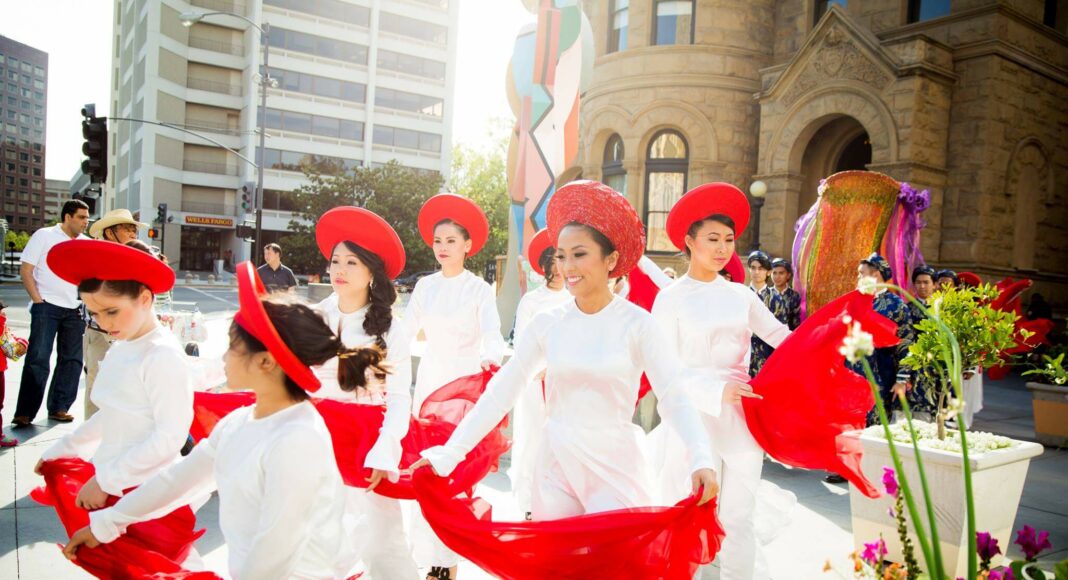The brightly colored ao dai dress is a powerful symbol for everything elegant about old Vietnam. Worn mostly by women, but also by men, the tunic-style garment has informed currents in Vietnamese fashion for centuries.
As such, it makes an appropriate centerpiece for the Ao Dai Festival—an ambitious event that aims to bring mainstream exposure to traditional Vietnamese style and culture.
The word—which can prove troublesome for the English tongue—is pronounced “ow-zye.” Translated from the Vietnamese, it means “long shirt.” The festival opens Saturday, May 12, with a downtown procession from San Jose City Hall to the San Jose Museum of Art, and continues with a ticketed concert and fashion show at the Fairmont.
The ao dai features slits to the waist on each side, is always worn with pants and comes in a dizzying variety of styles, cuts and colors. It carries many cultural associations for Vietnamese people and is still worn by Vietnamese-Americans for formal occasions, particularly weddings.
The Ao Dai Festival began in 2011 and became an every-other-year event the following year. It was founded by San Jose artist, activist and attorney Jenny Do in the wake of her photo documentary project on human sex trafficking, Humans for Sale.
“I was working with (mostly Vietnamese) victims in Taipei,” Do says, “and it was just so dark and horrific—really just beyond your comprehension.”
Faced with harrowing accounts from the trafficking victims that she interviewed—some reported being chained up naked around the clock—Do felt a need as an artist to symbolically restore what was lost for the victims. “I thought, I have to put the clothes back on these women.”
What followed became a festival celebrating not only Vietnam’s traditional dress, but its larger cultural heritage. The free-to-the-public procession in downtown San Jose will feature a rainbow of styles and designs of the ao dai, worn by men and women, Vietnamese and otherwise. The procession culminates in an opening ceremony at the Circle of Palms in the Fairmont Plaza, during which dancers will celebrate a well-known Vietnamese mythological tale.
“It’s the summoning of Mother Vietnam to come back to the children of Vietnam,” says Trami Nguyen Cron, who will serve as the tale’s narrator.
Meanwhile, at the San Jose Museum of Art, anyone interested can contribute to the making of a single community ao dai to be unveiled later in the festival.
The dinner show at the Fairmont, beginning at 6:30pm, will include a fashion show featuring some of the world’s most prominent designers of the ao dai, along with music from the Saigon Chamber Ensemble and the Upbeat Band.
The evolution of the ao dai has roughly parallelled Vietnam’s standing in the world, Do says. In men’s fashion, the garment largely went out of style in the 20th century because it was seen as a sign of an unsophisticated, agricultural Vietnam.
“Even today,” Do says, “I get a lot of resistance from men.”
For women, the ao dai moved dramatically from an indistinct boxy garment, designed to obscure the female body to a tightly fitted and tailored look, intended to highlight a woman’s curves. The move mirrored expanded rights for women in Vietnam and the outside world. Designers today are being more experimental with the ao dai than ever before.
“It has to be that once a person looks at the dress that the ao dai immediately comes to mind,” Do says. “The moment you move away from that, it becomes something else. It’s not to make the woman’s body cheap. It has to elevate the woman’s body and spirit. It’s well-covered, but it’s still very sensual. It’s an invitation for a person to gaze at her.”
“Generally, it is conservative,” Cron notes. “I’ve seen designs that are a bit more risqué, and there is some sexy stuff. But mostly it’s more conservative. When you see someone wearing the ao dai, they walk differently, they act differently. Probably that’s because it’s so constricting. But there is also a dignity to it.”
The Ao Dai Festival
May 12
Procession, 4:30pm, Free
San Jose City Hall
Evening Program, 6:30pm, $150
The Fairmont Hotel, San Jose



